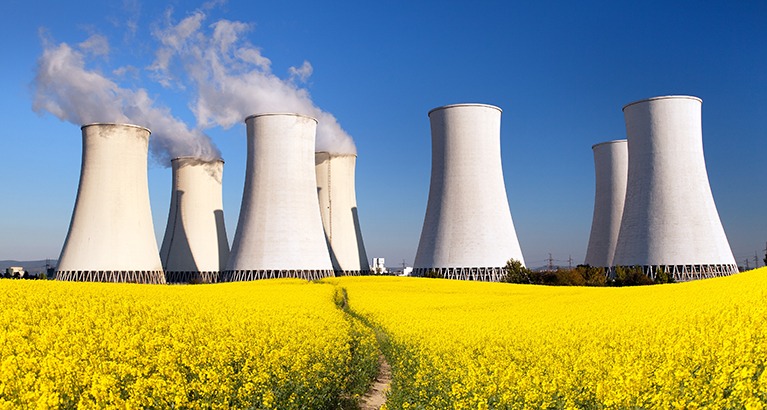The power of nuclear is its ability to extract a great deal of energy from a very small volume of fuel, providing a source of reliable, low-carbon electricity. Uranium is plentiful and distributed around the world, appealing to nations’ energy security needs in an age when the geopolitical landscape is shifting. And although the production of dangerous nuclear waste is undeniable, the emissions from nuclear power are widely considered to be clean. It has led some to talk of a nuclear renaissance.
The US, UK, France, India, China and Egypt are all at various stages of building or encouraging new investments in nuclear power. while others such as Poland appear open to the possibility. To fund such huge construction projects, many nations are looking, at least partly, at private financing.

Management Practice Professor Simon Taylor examines why nuclear must provide an economic and sustainability case if it is to be funded with bank or capital markets funds in a book chapter – “Can nuclear attract green finance?” – which is part of The Routledge Handbook of Green Finance.
“If a majority of investors decide that nuclear is not green, then a large fraction of capital market capacity, especially public markets and retail-based financial institutions, would be unavailable for nuclear investment, regardless of prospective risks and returns. In that case, governments would have to find the funding entirely themselves, putting some of the planned investment in jeopardy.”
“Nuclear power needs to be seen in a wider context because there is little that is completely sustainable in energy policy – recycling solar and wind energy components is difficult,” says Simon. “Supporters of nuclear therefore have a reasonable case that to exclude a proven source of low-carbon electricity on sustainability grounds is surely the greater evil. Not all investors will agree but it’s hoped enough will see nuclear as a worthy candidate for green finance. The ultimate decision-makers are the general public whose savings go into the mutual funds and pension funds that might fund nuclear energy.”
If a majority of investors decide that nuclear is not green, then a large fraction of capital market capacity, especially public markets and retail-based financial institutions, would be unavailable for nuclear investment, regardless of prospective risks and returns. In that case, governments would have to find the funding entirely themselves, putting some of the planned investment in jeopardy.
Exploring financing strategies for the global expansion of nuclear power
In 2020, nuclear energy made up 4% of total primary energy globally and about 10% of electricity generation. France is unusual in having such a large share of nuclear, with 77% of its electricity coming from nuclear power, and India and China are also expanding their growth in the area.
There are 13 countries with nuclear reactors currently under construction. Of these countries, Belarus, Bangladesh and Turkey are building reactors for the first time. Nigeria, Kenya, Laos, Morocco, Algeria, Philippines, Ghana, Rwanda and Ethiopia all have developing plans for nuclear.
There are 2 routes to financing:
Public financing
Many countries, including China and India, will finance this new nuclear energy mostly through the state budget. Given the pressures on public spending, finding private finance is also attractive. India plans to use more private finance in the future.
Private financing
The nuclear sector is in private ownership in Japan. In the United States nuclear is mainly owned by private investor-owned utilities. In the UK, the government plans to harness private finance with government support.
The challenge to securing private financing will be if investors, especially equity investors, decide that nuclear is not green or sustainable and doesn’t fit within an environmental, social and governance (ESG) framework. There are forecasts that ESG-related financial assets could rise to a third of the global total by 2025, so ESG opinions are likely to become increasingly important.
5 key tests to assess nuclear energy’s ESG compatibility
1
Construction and site impact
Nuclear power plants are among the largest and most complex civil engineering projects, due to the need for multiple safety systems and resilience to earthquakes and other hazards. They also need large amounts of concrete – each of the 2 bases at Hinkley Point C used around 49,000 tonnes of concrete, which is currently impossible to produce without generating CO2. A criticism is that nuclear isn’t a sustainable way to produce electricity – but that includes many other energy installations, including most windfarms.
2
Operation
Nuclear fission is inherently dangerous so nuclear power stations are tightly regulated in their operations. Radiation emissions are strictly controlled. Nuclear stations use a lot of water for cooling and there are regulations governing the temperature and manner of return of any water to the sea or river it was sourced from.
3
Fuel supply
Nuclear energy is fuelled by uranium, a metal that is relatively plentiful in the Earth’s crust. Since the fuel is finite and could face some physical or economic constraints in the future, it can be argued it is not sustainable in the sense that wind or solar energy is. But wind and solar PV-generated electricity require minerals in construction that are finite and may face supply constraints as capacity increases, and are more mineral-intensive relative to fossil fuel technologies. Some of these minerals are currently sourced from countries with problematic ESG credentials.
4
Waste disposal and decommissioning
Nuclear energy creates dangerous fission products and irradiates parts of the reactor. Both must be safely stored after decommissioning, the consensus being deep underground in a purpose-built facility. However, other industries, including renewable energy, do not necessarily account for the full life cycle of their operations, even when they also produce long-term waste.
5
Safety
Nuclear radiation is dangerous, which is why nuclear power stations are designed to make the release of radiation very unlikely and protect the environment if it does happen. Out of the 3 nuclear accidents, only Chernobyl (1986) led to many deaths, but Three Mile Island (1976) and Fukushima (2011) caused a lot of public anxiety. The so-called Generation III nuclear designs were an attempt to rebuild confidence following Three Mile Island and Chernobyl, but after a tsunami overwhelmed the Fukushima Daiichi plant in Japan there was a revival of German plans to close all its nuclear plants. The Generation III reactors are designed to be extremely safe – but it’s human error that has caused all the accidents so far.
Why nuclear power’s construction record poses barrier to conventional finance
“The key issue for new nuclear plants since Fukushima has been cost, not safety. Although there is no intrinsic reason why new nuclear could not attract conventional finance, in practice nuclear’s recent construction record makes it currently impossible.”
The construction of nuclear power plants in Europe and the United States has gone very badly. This a key challenge for investors. The risk can only be hedged, if at all, by signing a fixed-price contract with a construction company. This is the sort that bankrupted the company Westinghouse in 2017 in connection with 2 US nuclear projects. Westinghouse was originally American but was owned by the Japanese electrical conglomerate Toshiba at the time of its insolvency.
| Area of risk | Level of risk | Mitigation |
|---|---|---|
| Construction risk | Very high | Unhedgeable: state support now essential |
| Power price risk | High | Power purchase agreement usually available |
| Fuel cost risk | Minor share of costs | Hedgeable through contracts |
| Operating risk | Low | Operator needs regulatory approval |
| Third party liability risk | Low but potentially catastrophic | Limited by Paris Convention |
The key issue for new nuclear plants since Fukushima has been cost, not safety. Although there is no intrinsic reason why new nuclear could not attract conventional finance, in practice nuclear’s recent construction record makes it currently impossible.
What lessons can be learned from Hinkley Point C nuclear power plant?
Hinkley Point C nuclear station in the UK, which has been under construction since 2016, appears to be a successful case of a government managing to get private finance to fully fund the construction of a new nuclear power plant.
The 2 investors in the project, however, are both de facto state-owned enterprises. EDF was 84% owned by the French government at the time (now 100%) and CGN (one-third investor) is a Chinese state-owned company, with a subsidiary listed in Hong Kong.
The construction risk raised the investors’ required rate of return, which is reflected in the high price of electricity in the long-term contract. For the construction of the new Sizewell C plant, the UK government therefore sought new ways to attract private finance at a lower cost of capital and therefore lower electricity prices.
The so-called RAB (regulated asset base) model provides for an independent regulator to provide a guaranteed level of revenue in respect of the cumulative investment made by private investors, using the established framework of regulated network utilities in the UK. The RAB model was used in the funding of the Thames Tideway Tunnel.
Why is clarity needed on whether nuclear is eligible for green finance?
Currently there is no consensus on whether nuclear is green or not. Some governments, the Organisation for Economic Cooperation and Development (OECD) and the EU have kept the door open to nuclear as a form of sustainable investment.
The UK government, no longer part of the EU, published its own green financing framework which excludes nuclear. The Climate Bond Initiative accepts that nuclear is consistent with green principles but nonetheless fails to certify it as green. The opinions of investment decision-makers (managing other people’s money) and the ultimate investors (the public) are also important but systematic evidence on their opinions is currently limited.
The outcome for nuclear has wider implications for other technologies that may find their future constrained more by investor attitudes, than by their economic potential.
“The road to decarbonisation is likely to be a long one, and other technologies may emerge that divide opinion on their sustainability credentials, such as methods to remove carbon dioxide, nuclear fusion, climate repair and geoengineering, in roughly ascending order of controversy”, says the book chapter. “Clarifying what investors understand by green or ESG finance will be critical as to whether these technologies can access private finance, at competitive rates, or at all.”
The road to decarbonisation is likely to be a long one, and other technologies may emerge that divide opinion on their sustainability credentials, such as methods to remove carbon dioxide, nuclear fusion, climate repair and geoengineering, in roughly ascending order of controversy.
Featured faculty/academic
Simon Taylor
Management Practice Professor of Finance
Featured research
Taylor, S. (2023) “Can nuclear attract green finance?” In: Lehner, O.M., Harrer, T., Silvola, H. and Weber, O. (eds.) The Routledge handbook of green finance. London: Routledge, pp.374-390





